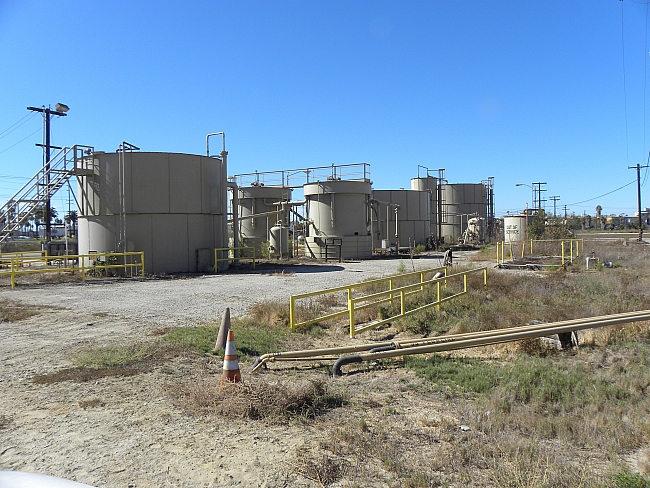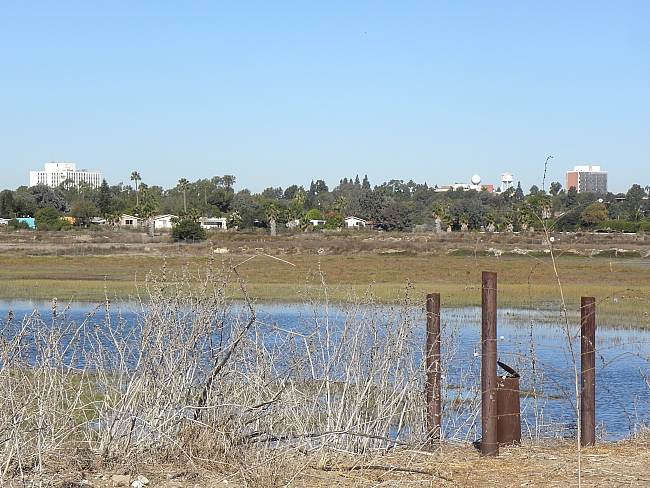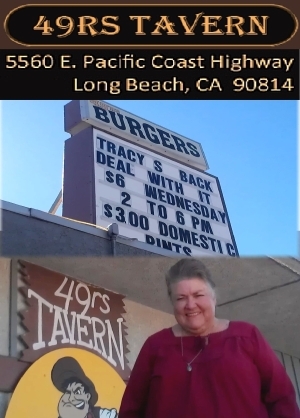
City of LB draft EIR graphic

Photo above shows current conditions

Second photo shows "Steamshovel Slough," not easily visible from offsite, that wetlands supporters call one of the most pristine salt marshes in all of Southern California.
A November 30, 2017 Planning Commission hearing produced sharply differing public testimony, with some prominent wetlands and wildlife groups conspicuously non-committal.
Project opponents Ann Cantrell (veteran LB environmental advocate, representing Citizens About Responsible Planning) and Anna Christensen/Charles Moore (the former a frequent advocate for native Americans, the latter an oceanographer/clean ocean advocate, now jointly representing Protect the Long Beach/Los Cerritos Wetlands) have appealed the non-elected Planning Commission's recommended project approval (7-0) to the elected City Council.
Sponsor | Sponsor |
BREAKING UPDATE: The Los Cerritos Wetlands Land Trust, a non-profit entity that has worked for decades to protect and restore the wetlands, hadn't taken a public position in the project...until this morning (Monday Jan. 15), when it issued a statement indicating that it now supports the proposed land exchange and mitigation bank. In a mass emailing, LCWLT Executive Director Elizabeth Lambe writes:
We admit it. It took us awhile. But after a great deal of research, discussion and with some additional protections put into place, the Board of Directors of the Los Cerritos Wetlands Land Trust has voted to support the mitigation bank and land swap proposed by Beach Oil Mineral Partners (BOM). We know the project has been the subject of great controversy and of strong opinion both for and against. We were, frankly, torn, in that we supported the idea of restoring Los Cerritos Wetlands but concerned it be done right, not take too long, and have the right balance of wetlands access and protection.In the end, we support this project because it includes comprehensive wetlands and habitat restoration, provides unique public access opportunities, consolidates oil operations offsite, and will transfer ownership of a substantial portion of Los Cerritos Wetlands into the public domain. These are all things for which the Land Trust has long advocated.
Our review process-of both the proposed oil consolidation and the restoration aspect of the project--was diligent and thoughtful. We formed a dedicated committee of Board members who did a great deal of their own research and reviewed all relevant information regarding the proposed project. We had numerous meetings with the BOM principals and their experts and consultants in order to ensure our many questions were answered and addressed.
We have always understood that the potential for wetlands restoration is the cornerstone of the project. However, the project area is known to be contaminated. We were concerned that site contamination could spread once outside water was introduced to the area. This could harm sensitive habitats and the species that depend on them. We were concerned that the restoration would not live up to its potential. To alleviate this concern, with BOM's agreement, we brought our own soil and water expert into the process in order to ensure we had a clear understanding of the details regarding contamination on the site and how best to remediate it.
BOM has been a transparent and integral partner in our review process, responding promptly to our many detailed questions and providing our committee with the answers they needed to understand the project. In addition, as this project is implemented, BOM has committed to involving the Land Trust in order to ensure we are fully updated and involved as the project moves through the regulatory review process.
The project offers tangible conservation benefits. It will reduce the footprint of oil operations to approximately 10 acres from approximately 187 acres, accelerating and funding a transformation of this highly degraded landscape to a restored functioning wetlands and uplands.
The project maintains environmental integrity. As a result of our conversations with the BOM team and advice from our soil and water consultant, BOM has committed to a thorough and transparent process regarding the assessment and removal of onsite hazards and contamination. This will ensure there will be no site contamination of Los Cerritos Wetlands as the land transitions from oil operations to conservation.
The project could offer conservation benefits sooner. Through conversations with BOM, we know they are committed to accelerating the transition to conservation if at all feasible.
Our watchdog role is integral and ongoing. BOM has agreed to full communication with us, including production numbers, to track BOM's adherence to its well abandonment schedule. The Land Trust's experts will play a significant oversight role, including helping to scope an ecological risk assessment prior to restoration work, receiving and reviewing any and all reports about site conditions, testing, and clean-up protocols. We will be on-site when excavation or other key activities occur.
We appreciate the time and effort BOM put into reaching out to us, the many meetings they had with us, and their fast response to our concerns. We consider BOM a partner and look forward to an enduring relationship with them. We hope this will serve as a model for other projects that will impact Los Cerritos Wetlands.
For all of these reasons, our Board has voted to support BOM's wetlands consolidation and restoration project and we look forward to a continuing partnership with them, the Los Cerritos Wetlands Authority, and other conservation groups in order to see through this joint commitment to transition from oil to conservation.
We know there are those who want conservation and restoration without the need for ongoing oil operations or a mitigation bank. But that was not on the table. We know there are differences of opinion on this matter and perhaps there always will be. However, it is my sincere hope that our community of environmental activists, who are working so hard to bring this damaged piece of wetlands back to life, will always operate from a place of respect for each other's views and understand that while others may have a different path towards protecting our fragile blue planet, our goals are shared.
We have deepest appreciation for all who have taken time out of their lives to advocate with us for the protection and restoration of Los Cerritos Wetlands. We have made great strides; and with your partnership and community support, I am sure we will continue to do so.
In November, a comment letter submitted in the EIR proceeding by LCWLT's attorney voiced concerns about the lengthy timeline for the wetlands restoration. In response, the City's draft EIR stated in pertinent part that the northerly portion of the site would be remediated, if necessary, and restored to a natural wetland area by year four once the project is implemented while oil operations on the site would continue on the southern portion of the site "for a fixed period of time of up to 40 years" and "would be phased out as new operations are established from the two slant drilling sites [Pumpkin Patch and LCWA parcel, NE corner Studebaker/2nd]. It added: "At this time, it is unknown at one point restoration of the southern portion would occur...However, ongoing communication with the applicant, City, LCWA, and interested parties would continue as a part of the overall restoration" of the wetlands and "the applicant, City, LCWA, and interested parties [p. 9-231]will continue to work collaboratively with LCWLT on accelerating the process."
In response to appellant Cantrell on the issue, the draft EIR states: "The project will reduce the number of operation oil wells by 50% within 20 years of the "New Occupancy Date" as that term is defined in the City's EIR, and by 100% within 40 years from the New Occupancy Date. The project proposes to drill 120 new wells which consist of a mix of oil wells, water injection wells and water source wells."
At the November 2017 Planning Commission meeting, Belmont Shore taxpayer Melinda Cotton said the prospect of restoring the wetlands was very exciting, but said the City should take steps to protect itself if the price of oil declines over the next 40+ years and might prevent the new entity from complete its restoration work as promised, leaving the City with the problem.
Supporters call the project a game-changer, a once in a lifetime chance that shouldn't be missed. In a Planning Commission colloquy, Assistant City Attorney Mike Mais indicated that if the proposed project isn't approved, Synergy Oil remains free to continue its present surface oil drilling operations without wetlands restoration.
Sponsor |  |
In its responses to EIR comments, the draft EIR's "Statement of Overriding Considerations" (listing grounds to approve the EIR despite some air quality impacts during construction) also states: "The City will receive an increase in tax dollars from the new oil production activities. Long Beach imposes a tax on oil production which is currently estimated at 40 cents/barrel of oil produced. As a result of this project, the incremental increase in annual tax proceeds from new oil production could, at maximum operating capacity, provide approximately $4 million in tax revenues to the City."
At the November 2017 Planning Commission hearing, a number of speakers in opposition raised the risk of pipeline breaks and possible oil spills, noting that the site is (literally) atop the Newport-Inglewood fault. The company and project supporters responded that the site has been an oil field for decades and if the project isn't approved, the current risk of pipeline breaks and oil spills will remain, and added that the restoration project will use newer equipment and pipelines applying more stringent codes than the current wells and pipes.
A number of public speakers in opposition also raised seismic issues, including the possibility of inducing seismic activity by the oil operations. The project applicant has stressed that it doesn't plan to conduct "fracking" (hydraulic fracturing of underground rocks to free up oil) on the site, but has acknowledged that it plans to separate water extracted as part of the oil drilling process, treat it and re-inject it back into the ground to prevent ground subsidence.
The Newport-Inglewood fault bisects the site and the oil operator proposes to use slant-drilling sites from two sites (east and west of the fault line) to avoid drilling directly across the fault. (One slant drill site would be from the NE corner of Studebaker/2nd St. site is east of the fault line; the other from the Pumpkin Patch site southward along PCH is on the west side of the fault line.)
The draft EIR's written materials (which the Planning Commission recommended that the Council certify) says the following about the risk of induced seismicity.
[Heading] Induced Fault Rupture, Seismic Event, and/or Seismic-Related Ground Failure [end heading]...[The] older wells on the Synergy Oil Field, City Property, and Pumpkin Patch sites would be replaced with newer wells installed on the Pumpkin Patch and LCWA [Studebaker/2nd St.) sites over time. The newer wells would be installed using directional drilling techniques that would target oil production zones. Some of the zones could be close to or bordered by the Newport-Inglewood Fault Zone. The removal of oil and produced water from the subsurface would reduce the volume of fluids in the production zone and, if not replaced, could result in a vacancy or voids that could cause subsidence that in turn could trigger a fault rupture, seismic event, and/or seismic-related ground failure. Discussions of researched cases where subsidence and seismic activity has been attributed to oil production are discussed in the white papers on Induced Seismicity (BOMP 2017b) and Water Injection (BOMP 2017c).
To prevent this, the oil industry has long used the practice of injecting the produced water that has been separated from the oil back into the production zone in order to avoid potential subsidence that could result if the vacancy or voids created by extraction of oil and water from the oil production zone is not refilled. The injection of water back into the production zone would prevent subsidence and reduce the potential to trigger fault rupture, seismic events, and seismic-related ground failure. If additional water is needed, water source wells would be used to extract groundwater from zones not susceptible to subsidence to augment the water that is pumped back into the oil production zones. Consistent with DOGGR regulations (see Section 3.5.3, DOGGR regulations), all injection wells would be equipped with an accurate, operating pressure gauge or pressure recording device and underground reservoir pressures would be closely monitored. As discussed in the above-reference white papers, the injection would be specifically and only back into the same oil production zone and not into underlying units; some induced seismic activity has been attributed to this practice. With the refilling of the oil production zone vacancies, the potential to induce seismic activity would be reduced to a less-than-significant level.
Source: EIR Geology section, p. 3.5-30
Sponsor | Sponsor |
Speakers in support at the Planning Commission hearing included Mark Stanley, Executive Officer of the Los Cerritos Wetlands Authority (a government body charged with providing "a comprehensive program of acquisition, protection, conservation, restoration, maintenance and operation and environmental enhancement of the Los Cerritos Wetlands" whose four member governing board includes LB Councilmembers Suzie Price and Roberto Uranga.) He was joined by Eric Zahn, project manager for LCWA, who said the prospect of restoring 154 acres of wetlands was previously nearly unimaginable, and can only be accomplished now by consolidating oil drilling off-site (as BOMP proposes to do.). Also testifying in support at the Planning Commission were area residents Lucy Johnson and Bill Thomas, along with Jeremy Harris, Exec. Dir. of the LB Area Chamber of Commerce.
The largest single opposition group at the Planning Commission consisted of speakers identifying themselves as Native Americans / indigenous peoples or their supporters, who said the site had previously been inhabited by LB's historic Tongva Tribe. Some said it had been a tribal burial ground; others mentioned the "Standing Rock" (South Dakota) oil pipeline (that ignited months of demonstrations/occupations on that site in 2016 (which ended only after President Trump took office and authorized the Obama-administration delayed project to proceed.) One noted that the City Council and Mayor Garcia recently sought credit for recognizing "Indigenous Peoples Day" (instead of Columbus Day.)
At the November Planning Commission hearing, Mary Parsell of El Dorado Audubon said the group is excited at the prospect of restoring a fully functioning wetlands, said it has concerns about some aspects of the project, but said the group has confidence the project will be a great success "once it clears all the requisite regulatory hurdles" (and reiterated and stressed the phrase), including regulatory approvals that will be required from the Coastal Commission, CA Fish and Wildlife and other regulatory agencies.
On the weekend of October 20-22, BOMP offered the public walking tours of the usually-inaccessible oil field that it offers to restore to 154 acres of natural wetlands. LBREPORT.com went on the walking tour on Sunday morning Oct. 22 and provides extended VIDEO and photo coverage below of what we saw and heard.
LBREPORT.com will provide LIVE streaming video of the Jan. 16 LB City Council meeting (scheduled start time 5:00 p.m.) at which the Los Cerritos Wetlands Oil Consolidation and Restoration hearing is the first substantive item on the Council agenda.
blog comments powered by Disqus
Recommend LBREPORT.com to your Facebook friends:
Follow LBReport.com with:
RSS |
Contact us: mail@LBReport.com





Hardwood Floor Specialists
Call (562) 422-2800 or (714) 836-7050
